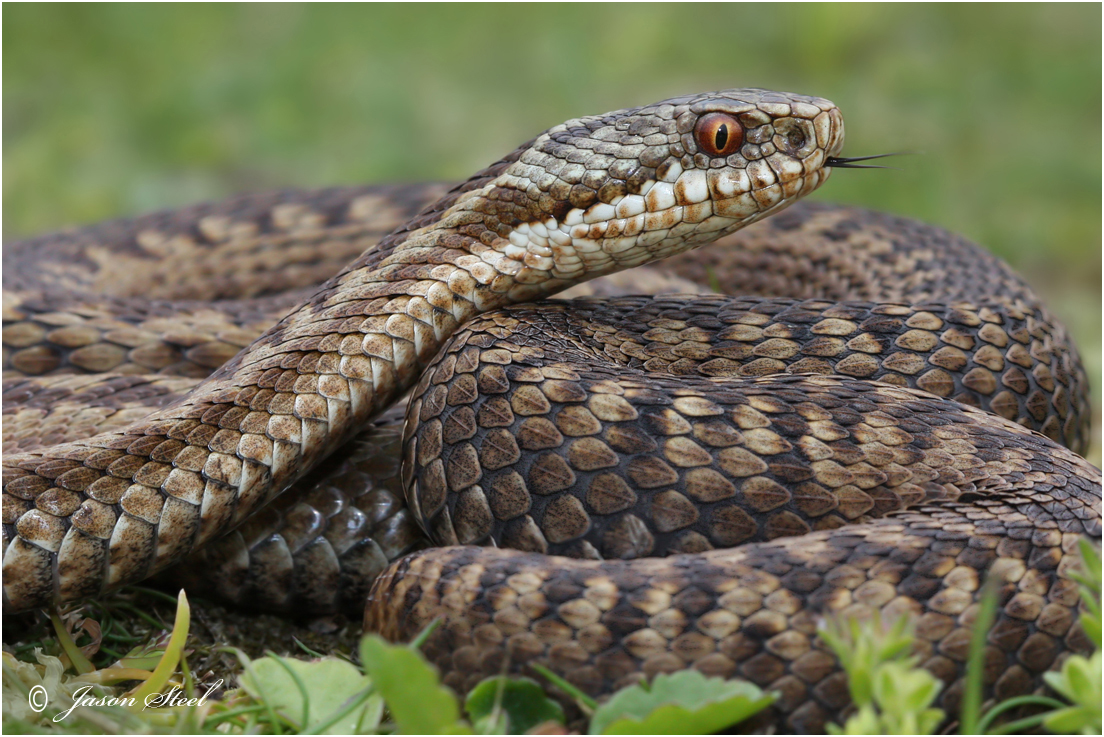
Adult female Adder.
The Common Adder (occasionally referred to as the Northern Viper, Crossed Viper, European Adder, European Viper ) is Britain's only venomous snake and is an 'old world' or 'true viper'. Adders can be clearly distinguished from the other two native British snakes (Grass Snake & Smooth Snake) by its orange / red eyes with elliptical pupils and the dark zig-zag patterns usually running the length of its back.
Adders can vary in colour considerably from light silvery grey, to various shades of brown. In addition it is not that uncommon to find black, melanistic, examples at some sites. The Adder is a very widespread species and its range spreads right across Europe (Including: Albania; Austria; Belarus; Belgium; Bosnia and Herzegovina; Bulgaria; China; Croatia; Czech Republic; Denmark; Estonia; Finland; France; Germany; Greece; Hungary; Italy; Korea, Democratic People's Republic of; Latvia; Lithuania; Macedonia, the former Yugoslav Republic of; Moldova; Mongolia; Montenegro; Netherlands; Norway; Poland; Romania; Russian Federation; Serbia (Serbia); Slovakia; Slovenia; Sweden; Switzerland; United Kingdom) and as far as Korea and North-West China. They can be found at altitudes ranging from sea-level up to 2700m in the Alps in Bulgaria. Populations at higher altitudes tend to have more melanistic specimens due to the advantages of thermoregulation in black reptiles. In the UK Adders are found across England, Wales and Scotland but are absent from Ireland, which has no snakes at all.
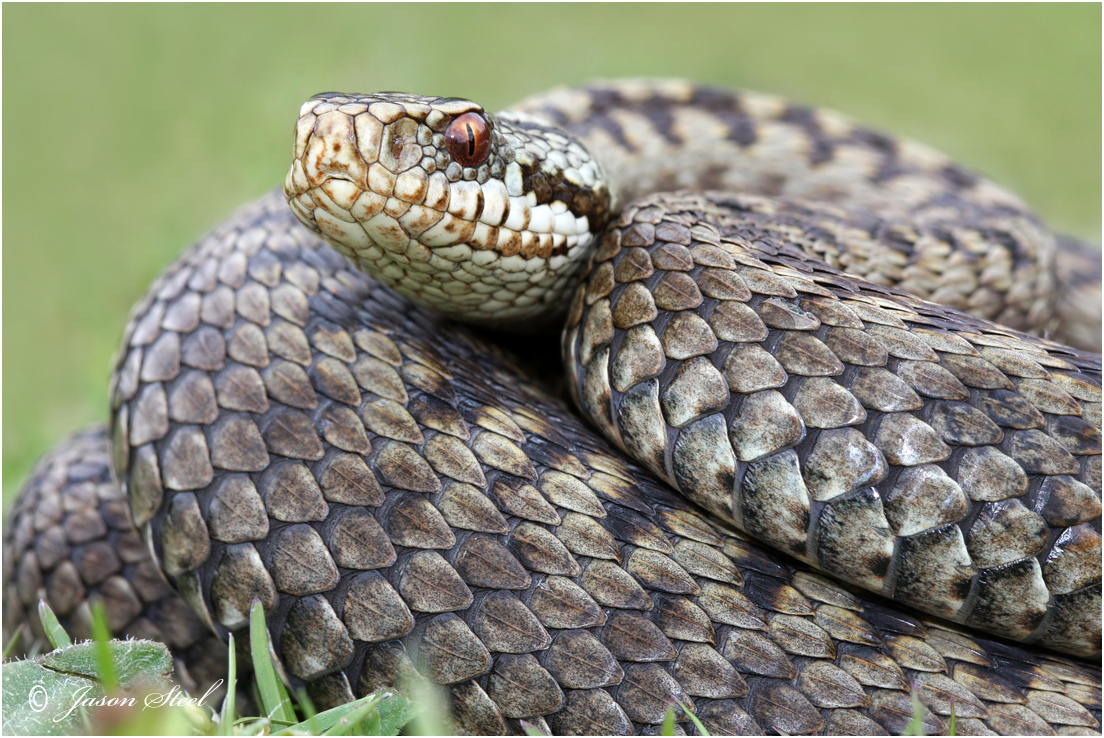
Adult female Adder.
The female Adder usually reaches around 55-60cm in total length and can reach sizes of up to 75cm. The male is smaller and usually reaches sizes of around 50cm and sometimes up to 60cm. The largest Adders found in this country have been about 87cm in length. There is a record dating from 1919 (by H.Smith) reporting an Adder in Härjedalen, Sweden to have reached 104cm in total length. And Finland has a record from 1931 of an Adder recorded at 94cm in total length.
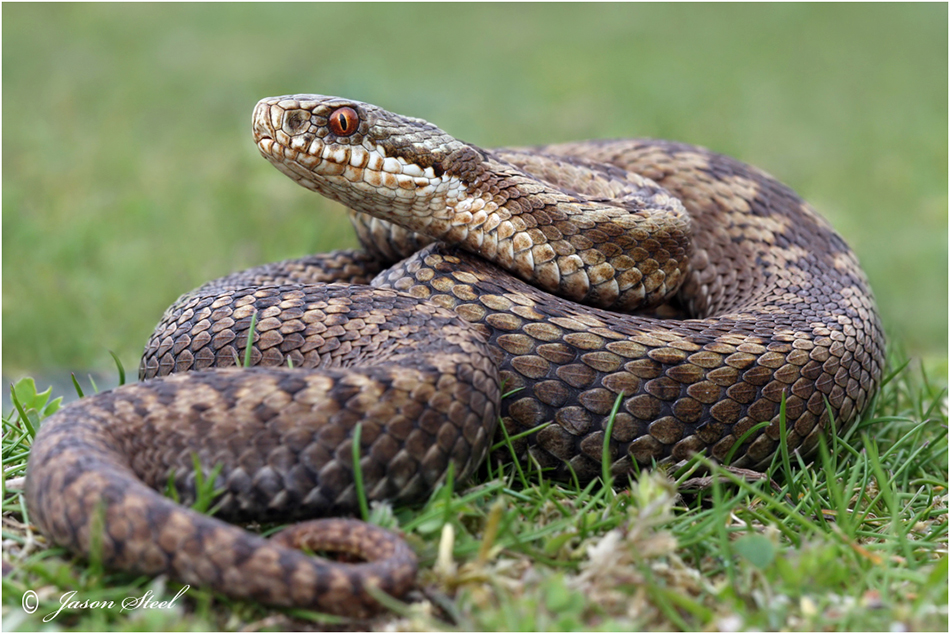
Adult female Adder.
Adders can be found in various habitats but tend to favour chalk grassland, woodland edges and heathland. Adders usually prey on small rodents (voles & mice) and lizards. They have also been known to occasionally feed on nesting birds, frogs and newts. After biting their prey and injecting a lethal dose of venom the adder will retreat and wait for the venom to take effect before tracking down the now dying victim by following its scent trail. When found the prey is swallowed whole, usually head-first.
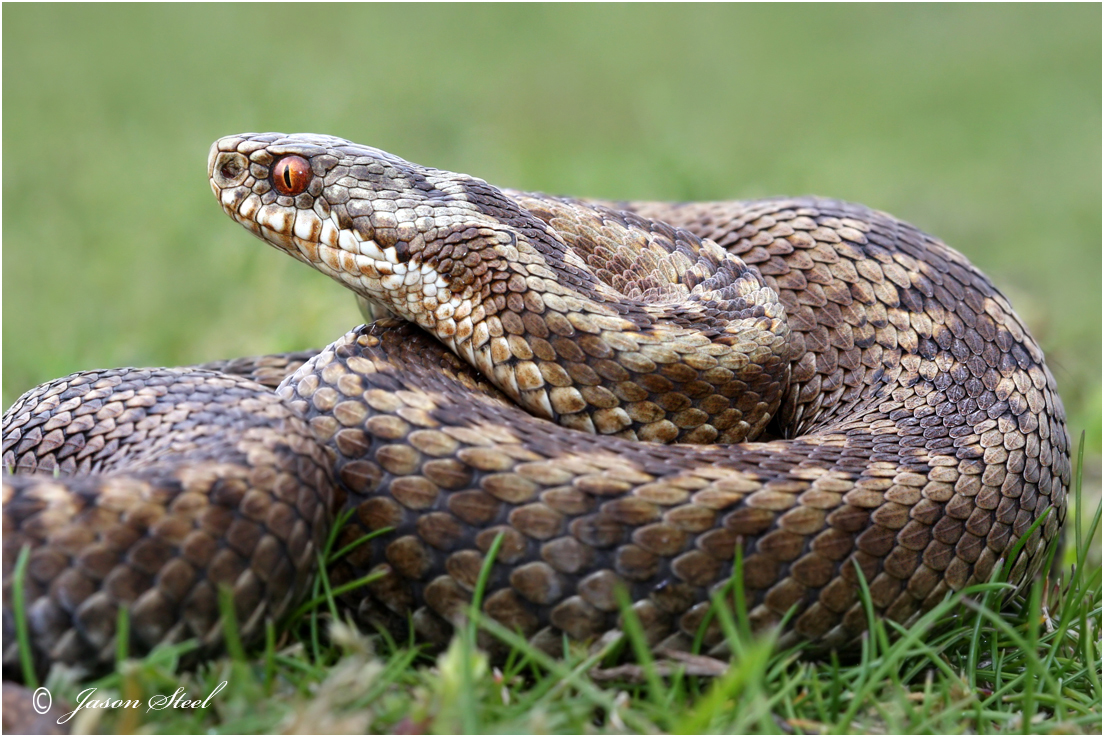
Adult female Adder.
Like all British reptiles the Adder is protected by UK Law (Wildlife and Countryside Act 1981) against being killed, harmed, sold or traded.
Although it is not illegal to catch Adders in the UK it is illegal to have them in your possession without a DWA (Dangerous Wild Animals) licence from your local authorities. Taking Adders from the wild is not advisable. Wild caught reptiles rarely thrive in captivity and don't make good pets. Wild-caught Adders are easily stressed and will often refuse to eat in captivity. They are also unlikely to breed in captivity. Adder numbers in the UK are in decline and this species is in need of our efforts to protect it.
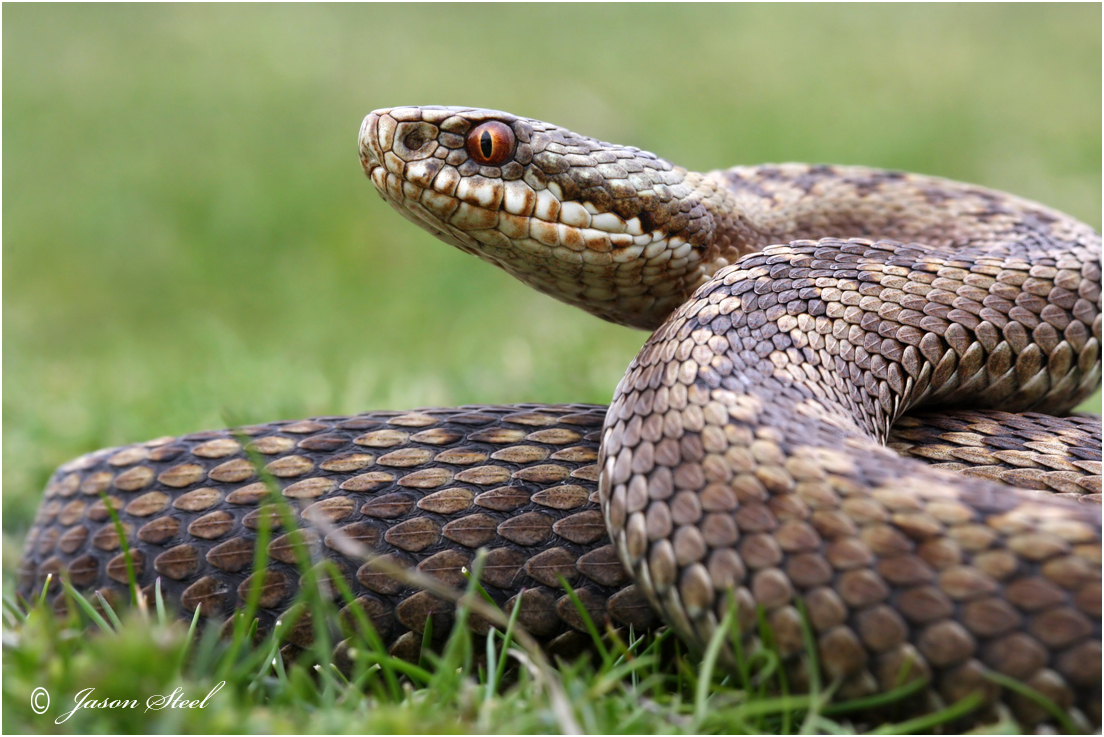
Adult female Adder.
The Adder is a shy creature and is not considered aggressive. It rarely bites unless trod on, handled or cornered. It will normally quickly disappear into the undergrowth at the first sign of trouble and would rather flee than waste valuable venom on a defensive strike. Sometimes an Adder will remain perfectly still and rely on its camouflage in the hope that it hasn't been seen. Most bites to humans are "dry bites" with little or no venom being injected. This is why you will often read that an adder bite is comparable to a wasp or bee sting. In cases where serious envenomation has occurred though the symptoms can be far more severe.
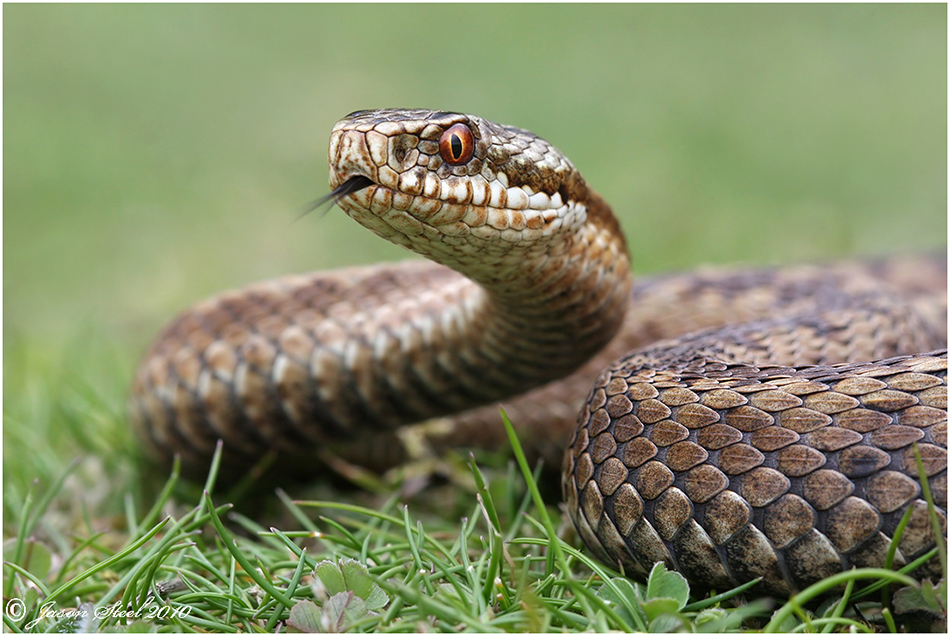
Adult female Adder.
When provoked the Adder will pull the front half of its body into an 'S' shape ready for a strike. Adders often inflate themselves and hiss loudly as a warning before striking.
Adder bites
Although very rarely fatal, Adder bites to Humans should be taken seriously and immediate medical attention should be sought. Adder bites are very painful and can be accompanied by nausea, loss of vision, dizziness, localised bruising and swelling of the bitten limb. Adder bites should not be underestimated. On rare occasions, envenoming can be life threatening, especially in children, and many adults experience prolonged discomfort and disability long after the bite. The last Human death from an Adder bite was a 5 year old child in 1975 who suffered a bite to his ankle in the Trossachs, in Scotland. Research triggered by this death in 1975 revealed that there had been only been 14 known human deaths from Adder bites in the previous 100 years. Data showed that during the period between 1950 - 1972 there was only one known death by an Adder bite throughout both England and Wales. However in the same 22 year period there had been over 60 known deaths resulting from bee and wasp stings in England and Wales!
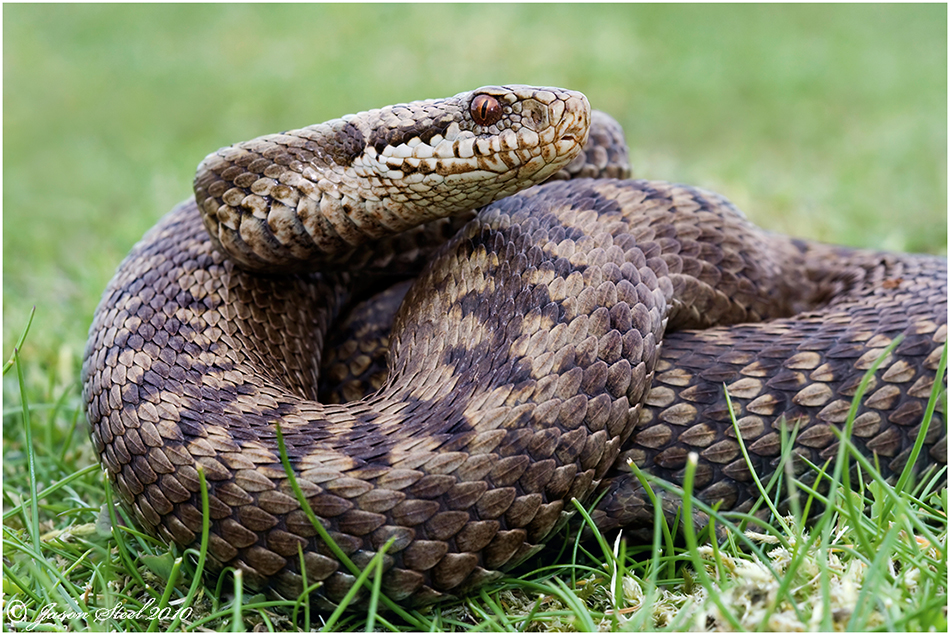
Adult female Adder.
Very occasionally Adder-bite victims have suffered from a very severe allergic reaction to the venom known as anaphylactic shock. This is a life-threatening condition which needs immediate medical attention. This condition is not specific to Adder bites though and can also be brought on by bee / wasp stings or something as simple as an allergy to nuts. If you suspect an Adder-bite victim may be experiencing anaphylactic shock then call 999 immediately as they will need an urgent injection of adrenaline.
Signs of anaphylaxis include:
- itchy skin or a raised, red skin rash
- swollen eyes, lips, hands and feet
- feeling lightheaded or faint
- narrowing of the airways which can cause wheezing and breathing difficulties
- abdominal pain, nausea and vomiting
- collapse and unconsciousness
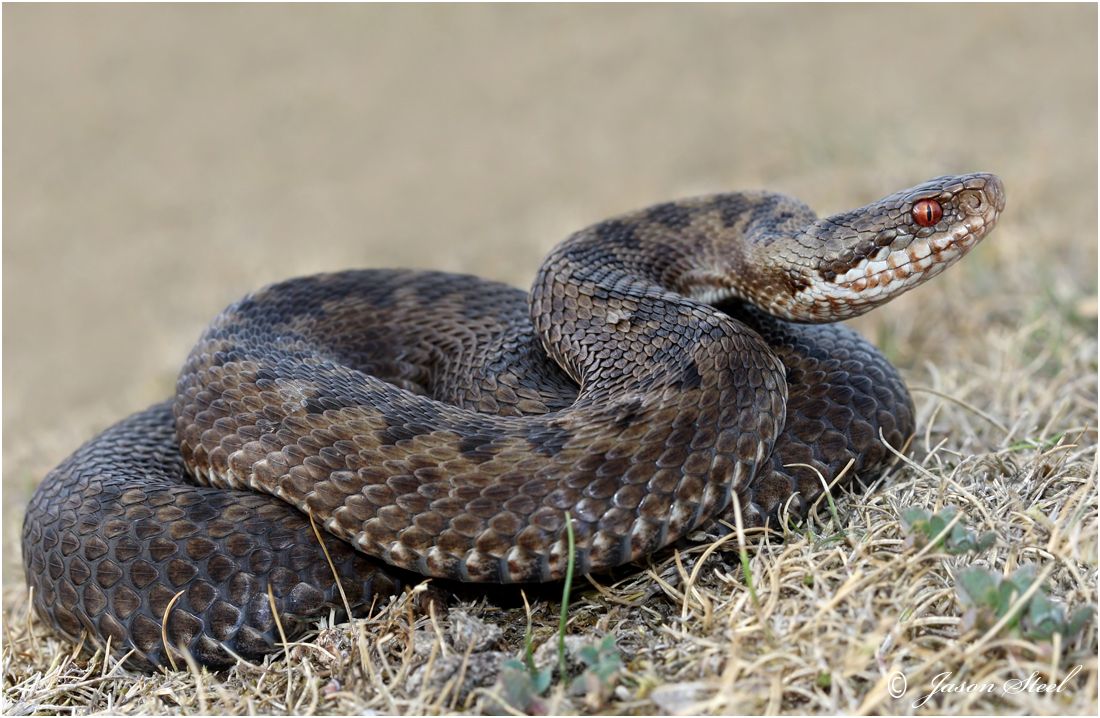
Adult female Adder.
What to do if someone is bitten by an adder:
Seek immediate medical attention. Keep the victim calm and try to keep walking to a minimum to reduce the spread of the venom around the body. If possible keep the bitten area below heart level to reduce the venom spreading around the body. Do not give the victim any medication, food or drink until after the victim has sought medical aid. Do not apply a tourniquet or attempt to suck out the venom. LINK
Although Adder bites to a child can be more serious than bites to an adult children usually recover faster. Children usually recover completely in 1-3 weeks but most adults take 3 weeks or more to recover. 25% of adults that have been envenomated take between 1 month and 9 months to fully recover according to the British Medical Journal. Click here
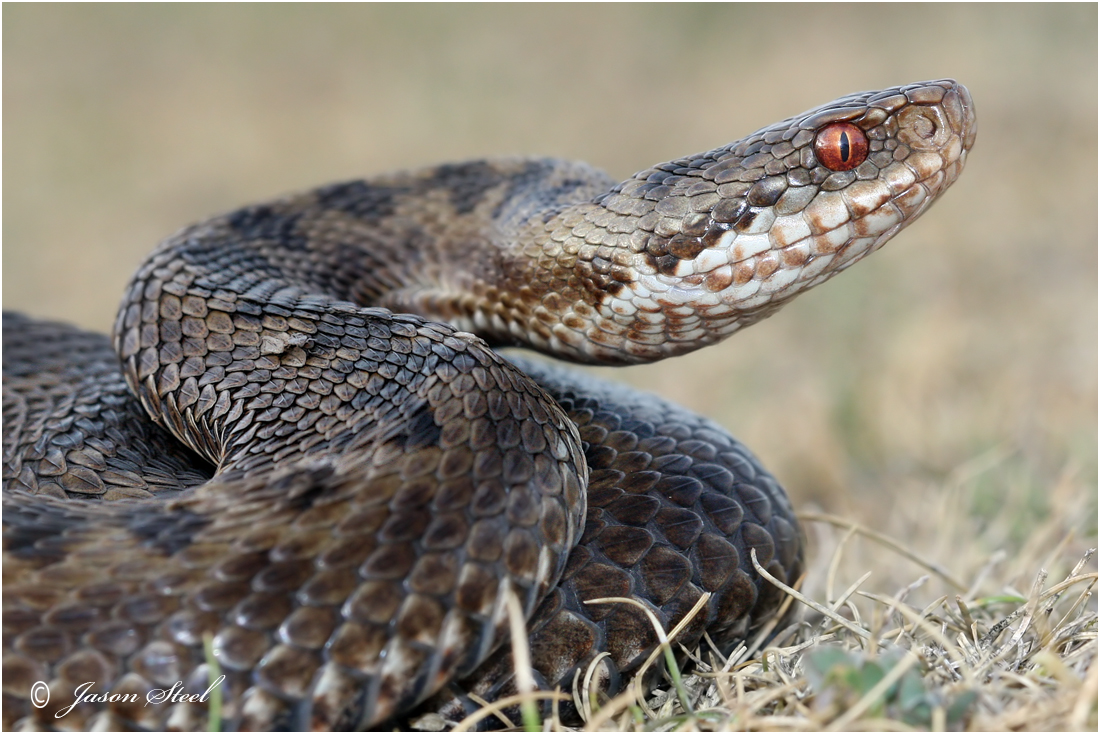
Adult female Adder.
In 2004 an 81-year-old woman died following an Adder bite to the middle finger on Rügen Island, Breege, Germany. The emergency services arrived 15 minutes later but the 81 year-old had lost consciousness, and died despite resuscitation attempts. It is believed the victim's age and medical condition prior to the bite, played important factors in her death.
When treating Adder bites to humans hospitals will typically administer antibiotics and antihistamine drugs. If the symptoms are serious enough then antivenin may also be given to the patient. The most widely used antivenin used to treat Adder bites is Zagreb, which is also used to treat other types of European viper bites. Anti'venom is produced by injecting very small amounts of venom into horses. They usually start by injecting about 1/10 of the dose that would be lethal to the horse. The horse usually has no problem producing enough antibodies to neutralise the venom. This venom is injected into the horse regularly and the dosage is gradually increased until the horse can withstand doses far higher than the amount usually sufficient to prove lethal. Blood is then taken from the horse and the horse's antivenin antibodies are extracted and purified to produce antivenin that can be used to treat humans. Horses are used more than other animals because of their size and the large quantities of anti-venom antibodies they therefore produce. Unfortunately some patients treated with anti-venom can suffer an allergic reaction due to the human body's intolerance to the horse serum part of the antivenin.
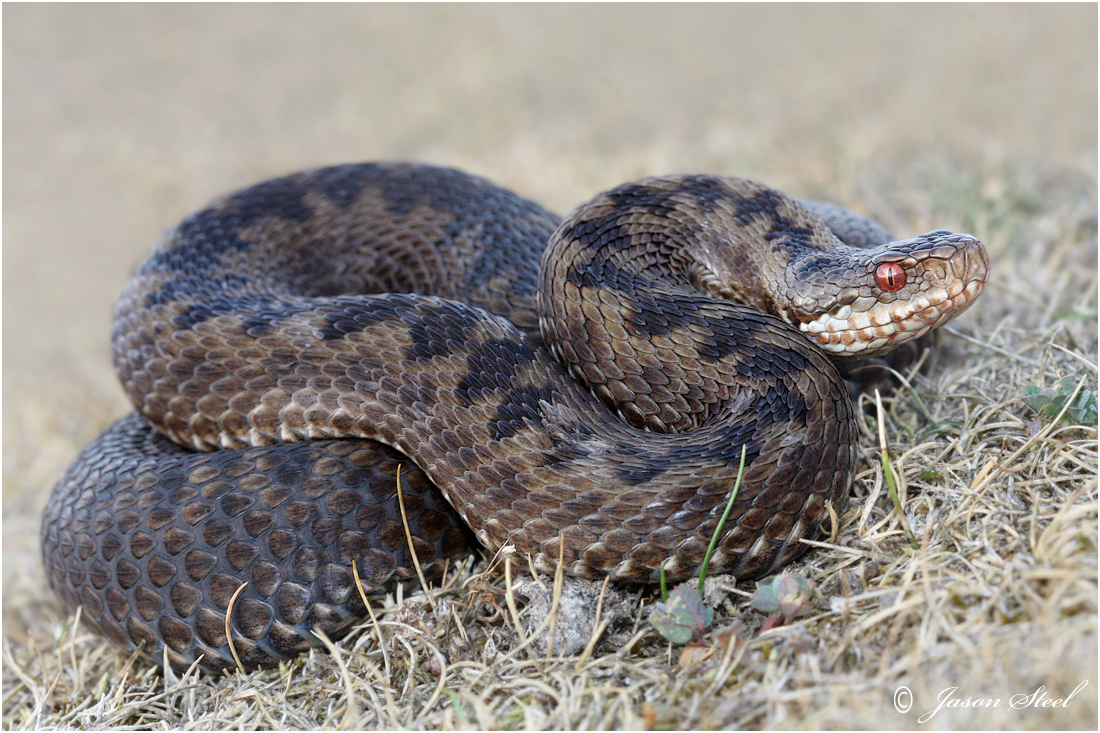
Adult female Adder.
Adder bites to cats and dogs
Adder bites to domestic cats and dogs should be taken seriously and veterinary help should always be sought. According to a report published in August 2011 by the British Veterinary Association 97% of dogs suffered significant morbidity and even after treatment 4.6% of dogs treated failed to survive the Adder bite.
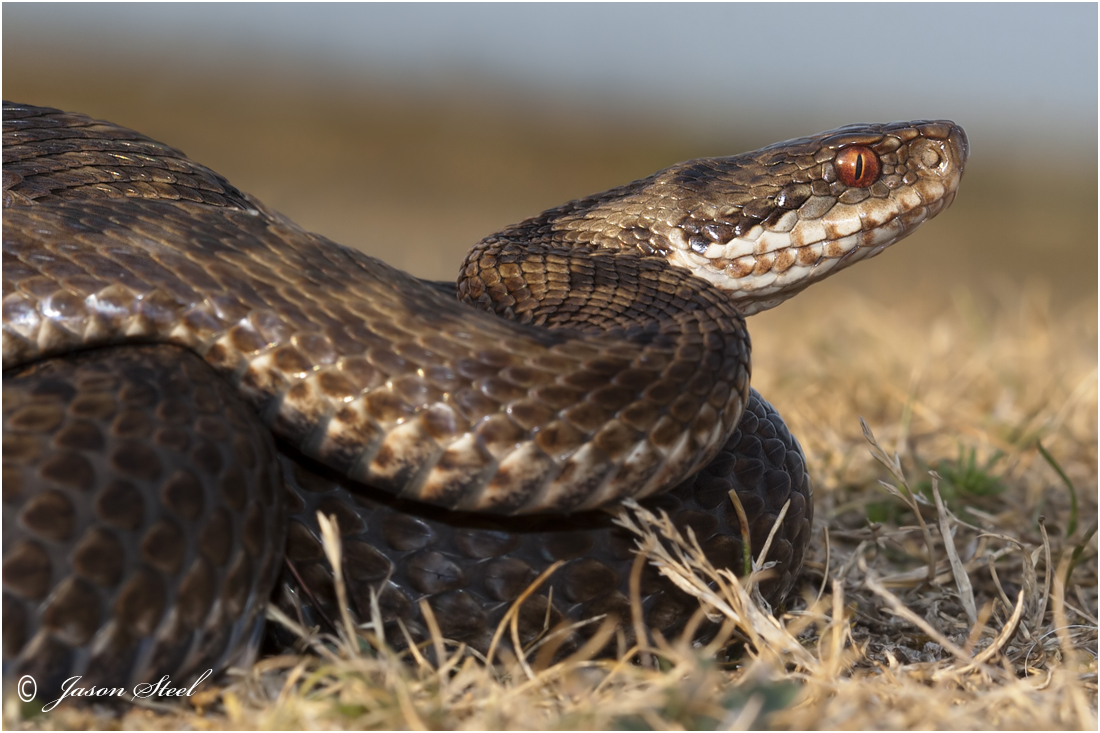
Adult female Adder.
Dogs are relatively frequent victims of adder bites due to their inquisitive nature of exploring undergrowth and their curiosity. Although less than 5% of Adder bites to dogs prove fatal this is largely due to prompt veterinary attention so any Adder bite should be treated as an emergency. Bitten dogs may suffer from swelling, bleeding and fever. They may also go into shock. K9 victims can also suffer from liver and kidney poisoning so the quicker you can get your dog to a vet the greater chance of its survival. The best way to avoid your dog being bitten by an adder is not to allow it off the lead in areas where adders are known to be present.
What to do if your dog is bitten by an Adder:
If necessary try to scare the Adder away by stamping on the ground. If absolutely necessary then remove the Adder with a long stick. (Do not harm the snake). Try to keep your dog calm and relaxed. Phone a local vet immediately and inform them that you are on your way with a suspected Adder-bite victim. Carry your dog to a vehicle and transport it to the vets without delay. If the dog is bitten on the face then you may need to loosen the dog's collar as localised swelling could result from the bite. Do not apply a tourniquet, ice or heat to the bitten limb. Do not attempt to extract the venom from the wound. These procedures are ineffective and may even cause further harm to your pet.
Some vets advise carrying Piriton tablets if you walk your dog in areas known to be inhabited by Adders. Piriton (active ingredient chlorphenamine maleate) is a sedating antihistamine tablet which may buy your dog time if bitten by an Adder until you get the dog to the vets.
In severe cases a vet may choose to administer antivenin (Zagreb) to your dog. In an emergency veterinary professionals can source this antivenin 24hrs a day by phoning the Vetinary Poisons Information Service (VPIS) 020 7188 0200 or they can email: info@vpisglobal.com For more information click here. To find your nearest vet in an emergency situation such as an adder bite click here.

Adult female Adder.
Female Adders usually reproduce once every two years and are ‘viviparous’. This means that they give birth to live young which are initially encased in a thin membrane (which they escape from immediately upon or after birth) unlike Grass Snakes which are the only native snakes in the UK to lay eggs. Towards the end of August or early September, the female Adder will normally return to the site of hibernation, and give birth to 3-18 young with 10 being the average number. Few of these young snakes will reach adulthood mainly due to predation.

Adult female Adder.
Male and female Adders are at their easiest to tell apart during the spring and early summer months. During these months the males are usually very light grey / cream with dark black zig-zag markings. The females tend to be fairly light brown with quite dark brown markings. Later in the year the males often darken and appear as a dirty brown colour but still have the black markings. The most definite means of sexing an Adder is to focus on the tail. Males have longer, thinner tails with a slight bulge at the start and females have a shorter, stubbier tail that ends quite abruptly. Obviously the tails of an Adder are not always easy to see. Male Adders also have heavier and bolder more obvious side markings than the female. Another way of sexing Adders is to look carefully at the rostral scale. This is the scale at the very tip of the Adder's snout. Males tend to have a black border around this scale. Females have a paler brown border around this scale.
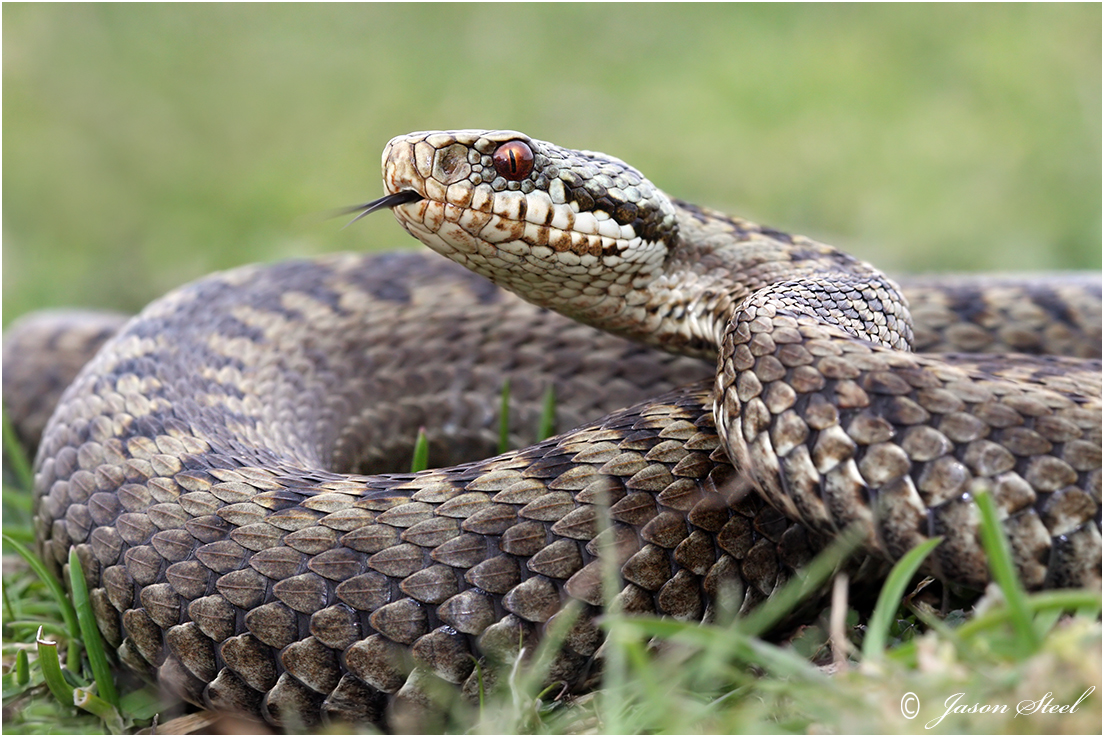
Adult female Adder.
Adders are estimated to usually live for less than 25 years but can live for well over 30 years in the wild if they can evade predators. They are quite hardy for a reptile and are the most northerly distributed snake in the world. In fact they are the only snake in the world to be found within the Arctic Circle. Adders found in Lapland are mainly black (melanistic) as this allows them to absorb the suns rays more efficiently and warm up quicker. Adders in this region are forced to hibernate for 9 months of the year. They emerge when snow still lays on the ground.
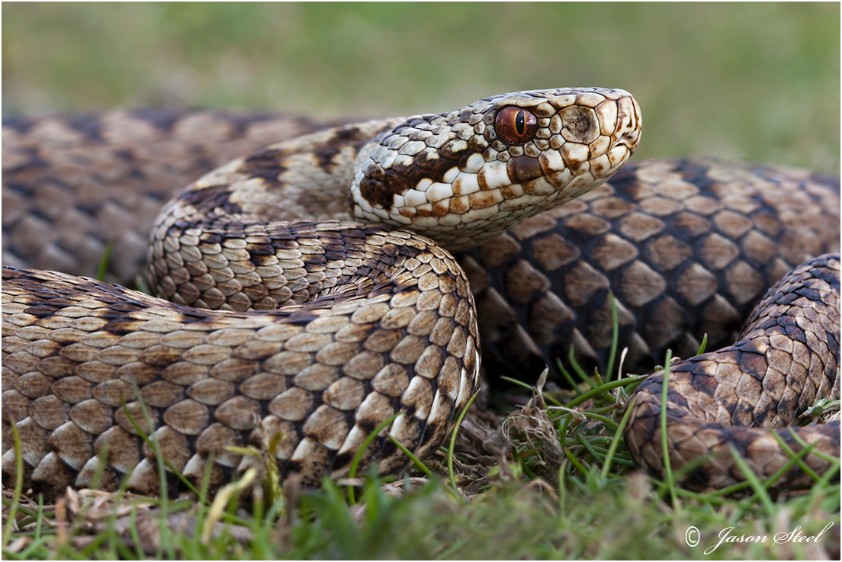
Adult female Adder.
The best way to observe Adders in the wild is to join your local Reptile & Amphibian Group and attend their special guided field trip days out. You will learn of sites near you that support Adder colonies and learn how and when you are most likely to spot them.
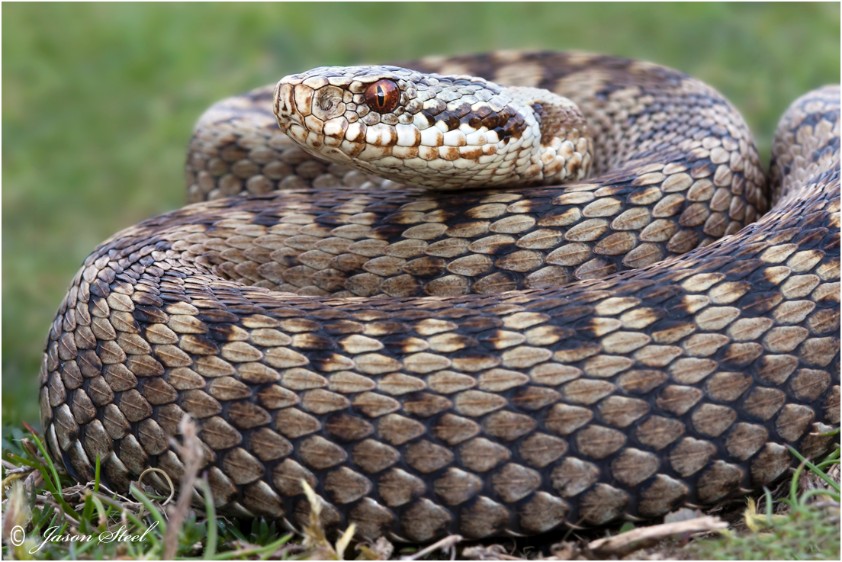
Adult female Adder.
Although Adders are ground-dwelling snakes they, like most snakes, are very competent climbers. There is a superb photographic account on Facebook from 2019 of an Adder climbing a tree and entering the hollow tree through a small hole to invade the nest of a Blue Tit. The snake then emerges with a Blue Tit in its jaws. The Adder then takes its prey to the ground before swallowing it. See account here.
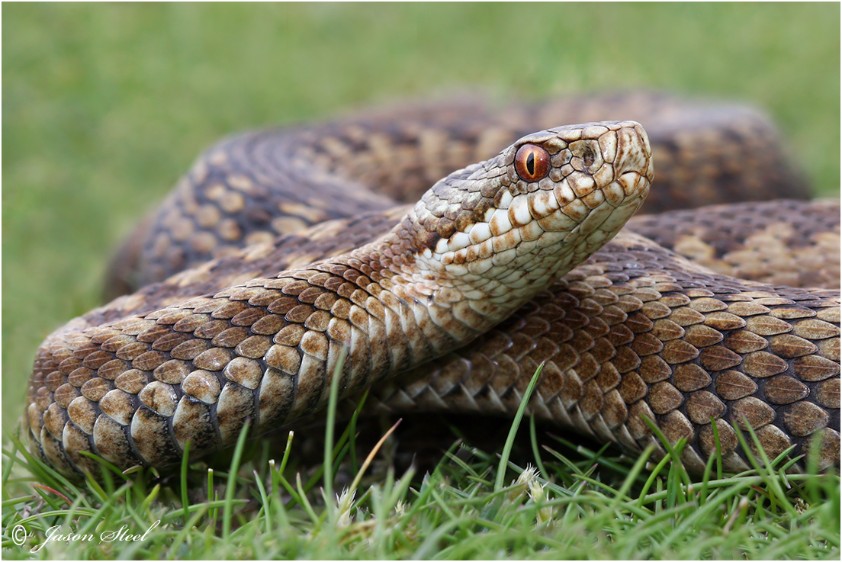
All these Snake photos were taken using the Canon 40D Camera and Canon 100mm 2.8 Macro lens.
Please remember that all images on this site are the property of Jason Steel are are copyright protected. Please contact me if you wish to use any of them.